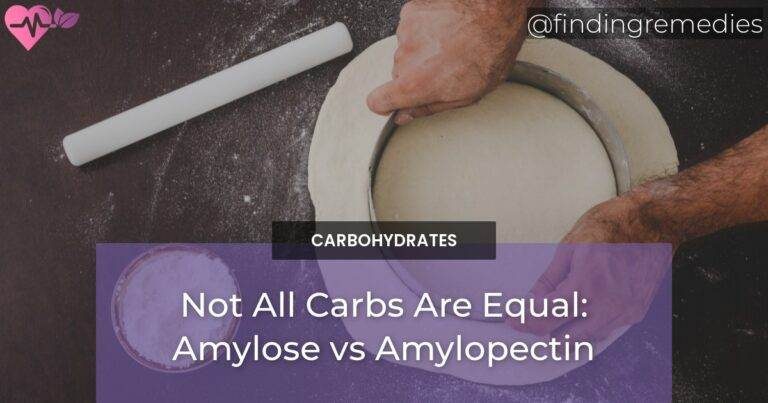Carbohydrates are a vital source of energy for our bodies, and they come in various forms. One of the main types of carbohydrates is starch, which is made up of two components: amylose and amylopectin. Although they are both starches, amylose and amylopectin have distinct chemical structures and behave differently in our bodies.
Understanding the differences between Amylose vs Amylopectin can help us make informed choices about our diet and lead to better health outcomes.
Table of Contents
Chemical Structure of Amylose and Amylopectin
Amylose Chemical Structure
Amylose is a linear chain of glucose molecules, connected by α(1→4) glycosidic bonds. It is a long and straight molecule with relatively few branching points. This linear structure gives amylose its characteristic properties and determines how it is digested and metabolized in our bodies.
Amylopectin Chemical Structure
Amylopectin, on the other hand, is a branched molecule. It consists of a main chain of glucose units connected by α(1→4) glycosidic bonds, similar to amylose. However, it also contains occasional α(1→6) glycosidic bonds, which create branch points in the molecule. This branching structure gives amylopectin its unique properties and influences its digestion and glycemic index.
Digestion of Amylose and Amylopectin
ALSO READ
Digestion of Amylose
Amylose is digested more slowly than amylopectin due to its linear structure. The enzymes in our saliva and pancreas break down the α(1→4) glycosidic bonds in amylose, converting it into smaller glucose molecules. This gradual release of glucose into the bloodstream leads to a slower rise in blood sugar levels and a lower glycemic response.
Digestion of Amylopectin
Amylopectin, with its branched structure, is more quickly and easily digested compared to amylose. The enzymes in our body can hydrolyze both the α(1→4) and α(1→6) glycosidic bonds, resulting in a rapid release of glucose into the bloodstream. This leads to a quicker rise in blood sugar levels and a higher glycemic response.
Glycemic Index of Amylose and Amylopectin
ALSO READ
Glycemic Index of Amylose
The glycemic index (GI) is a measure of how quickly a carbohydrate-containing food raises blood sugar levels. Foods with a high GI cause a rapid spike in blood sugar, while those with a low GI result in a slower and more controlled increase. Amylose, being slowly digested, has a lower glycemic index compared to amylopectin. Foods rich in amylose, such as whole grains, legumes, and certain fruits, provide sustained energy and can help regulate blood sugar levels.
Glycemic Index of Amylopectin
Amylopectin, due to its rapid digestion, has a higher glycemic index compared to amylose. Foods containing amylopectin, such as white bread, white rice, and processed snacks, cause a quick rise in blood sugar levels. These high-GI foods can lead to a rapid energy boost followed by a crash, potentially contributing to weight gain, insulin resistance, and other health issues.
Health Impacts of Amylose and Amylopectin
Health Impacts of Amylose
Amylose’s slower digestion and lower GI make it beneficial for overall health. It provides a sustained release of energy, helps regulate blood sugar levels, and promotes feelings of fullness. Additionally, foods high in amylose are often rich in fiber, vitamins, and minerals, making them more nutritious and supportive of digestive health.
Health Impacts of Amylopectin
Amylopectin’s quick digestion and higher GI may have negative health impacts when consumed excessively or without moderation. Foods high in amylopectin can lead to rapid blood sugar spikes, insulin resistance, and increased risk of chronic diseases such as type 2 diabetes and obesity. However, it’s important to note that the overall diet and other factors also play a significant role in determining health outcomes.
Here is a table comparing the key differences between amylose and amylopectin:
| Amylose | Amylopectin | |
|---|---|---|
| Chemical structure | Linear chain of glucose molecules connected by α(1→4) glycosidic bonds | Branched chain of glucose molecules with α(1→4) and α(1→6) glycosidic bonds |
| Digestion | Broken down slowly by enzymes, gradual release of glucose | Broken down rapidly by enzymes, quick release of glucose |
| Glycemic index | Low GI, slower rise in blood sugar | High GI, rapid rise in blood sugar |
| Health impacts | Provides sustained energy, helps regulate blood sugar | Can lead to rapid blood sugar spikes if consumed excessively |
| Food sources | Whole grains, legumes, some fruits | Refined grains, white rice, processed snacks |
The key points are:
- Amylose has a simpler linear structure while amylopectin is a branched molecule.
- Amylose is digested slower and has a lower glycemic index.
- Amylopectin is digested faster and has a higher glycemic index.
- Amylose provides sustained energy while amylopectin can cause blood sugar spikes.
- Good sources of amylose include whole grains and legumes. Amylopectin is found in refined grains and processed foods.
Conclusion
Amylose and amylopectin are the two main components of starch, but their distinct chemical structures result in different digestion patterns and glycemic responses. Amylose’s simpler linear structure leads to slower enzyme digestion and a lower glycemic index. This provides sustained energy release and helps control blood sugar. Amylopectin’s branched configuration allows for more rapid enzymatic breakdown and quicker glucose absorption, resulting in a higher glycemic response. While amylopectin foods can cause blood sugar spikes if over-consumed, amylose foods like whole grains and legumes promote stable energy and better blood sugar regulation. Overall, understanding the contrasts between amylose and amylopectin, including their structures, digestion, and impacts on our health, can empower us to make informed dietary choices that improve our wellbeing. Selecting foods with more amylose and less amylopectin can promote sustained energy, healthy blood sugar control, and reduced risk of chronic diseases.

